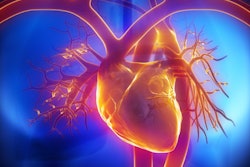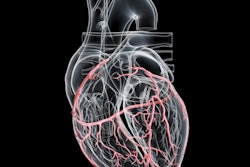
By detecting high-risk plaque, coronary CT angiography (CCTA) can predict major adverse cardiovascular events (MACE) in patients with stable chest pain, according to a January 10 study in JAMA Cardiology. But the jury is still out on whether CCTA findings should be added to risk stratification tools such as Framingham scores.
Individuals with stable chest pain who had high-risk plaque on CCTA scans were almost three times as likely to have a major cardiac event as those who didn't show high-risk plaque, according to researchers. Those with imaging signs such as positive remodeling, low CT attenuation, and the napkin-ring sign had a 70% higher risk of future MACE that was independent of whether they also had cardiovascular risk factors and obstructive coronary artery disease (CAD).
"Our results demonstrate the clinical significance of detecting individual high-risk plaques relative to standard clinical risk factors and obstructive CAD," wrote the research team led by first author Dr. Maros Ferencik, PhD, of Oregon Health and Science University (JAMA Cardiol, January 10, 2018).
Getting to the heart of the matter
CCTA has already carved out a role as a useful tool for patients presenting with symptoms like chest pain that point to obstructive coronary artery disease. But more than half of cardiac events occur in patients with nonobstructive CAD. The researchers wanted to see whether the presence of high-risk plaque on CCTA scans could be used to predict events in these individuals independent of stenosis or cardiovascular risk factors such as Framingham scores.
Ferencik and colleagues analyzed a subgroup of individuals drawn from the Prospective Multicenter Imaging Study for Evaluation of Chest Pain (PROMISE), a large trial of more than 10,000 individuals that was conducted from 2010 to 2013 and compared CCTA scans with functional imaging. Drawing patients from the CCTA arm of the study, the researchers settled on a population of 4,415 individuals.
Readers analyzed the CCTA images by coronary segment for the presence of high-risk plaque or significant stenosis, ultimately finding that 676 study participants had high-risk plaques and 276 had significant stenoses. They then tracked the outcomes of the individuals, with MACE defined as cardiovascular death, myocardial infarction, or hospitalization for unstable angina.
In all, 131 of the 4,415 individuals experienced a major adverse cardiovascular event, for an incidence rate of 3.0%. Patients with high-risk plaque had a MACE rate of 6.4% (43 of 676), compared with 2.4% (88 of 3,739) for patients without high-risk plaque; the hazard ratio for MACE in patients with high-risk plaque was 2.73.
| Value of high-risk plaque on CCTA for predicting MACE | |
| Overall rate of MACE in study population | 3.0% |
| Rate of MACE in patients with high-risk plaque | 6.4% |
| Rate of MACE in patients without high-risk plaque | 2.4% |
| Hazard ratio of MACE in patients with high-risk plaque | 2.73 |
| Sensitivity of high-risk plaque for MACE | 32.8% |
| Specificity of high-risk plaque for MACE | 85.2% |
| Positive predictive value of high-risk plaque for MACE | 6.4% |
| Negative predictive value of high-risk plaque for MACE | 97.6% |
The researchers concluded that the presence of high-risk plaque on CCTA scans of outpatients with stable chest pain brought with it a 70% increased risk of MACE in the future. CCTA scans were most valuable for individuals with nonobstructive CAD and those with a lower burden of atherosclerosis, such as younger patients and women.
On the other hand, the researchers were unable to demonstrate that CCTA can identify specific high-risk plaque features that could help detect vulnerable lesions before they lead to MACE. This was mostly due to the relatively low rate of adverse events among those with high-risk plaque in the study, at 6.4%.
The findings indicate that the presence of high-risk plaque on CCTA scans should be included in patient reports because it can help reclassify the risk of individuals, particularly younger patients and women, Ferencik and colleagues suggested. While women typically have a lower burden of coronary plaque, they also have smaller coronary arteries, which could lead to symptomatic disease even with a lower plaque burden.
Finally, the group suggested that the presence of high-risk plaque on CCTA scans could become a new risk-stratification tool, especially in patients with nonobstructive CAD. This could lead to lifestyle modification through diet and exercise or pharmaceutical treatment with lipid-lowering drugs.
Just hold on there
Not so fast, according to an editorial in JAMA Cardiology that accompanied the study. In the editorial, Dr. Raymond Gibbons from the Mayo Clinic in Rochester, MN, questioned whether the findings by Ferencik et al are significant enough to warrant the addition of a new variable to cardiac risk assessment.
Gibbons noted that the presence of high-risk plaque on CCTA only had a 6.4% positive predictive value for MACE in the study; as such, only one in 33 patients with high-risk plaque are likely to have a "hard" cardiac event and therefore benefit from classification with the proposed variable. Also, high-risk plaque did not predict more MACE in individuals with significant stenosis, which suggests that directing these individuals to therapy with percutaneous coronary intervention would be of limited value.
"The detection of high-risk plaques by coronary CTA is an appropriate subject for future research exploring the pathophysiology of plaque biology and its intersection with acute coronary syndromes," Gibbons wrote. "However, in my opinion, the evidence is not yet strong enough for us to use it in the clinical care of patients with [stable ischemic heart disease]."




















